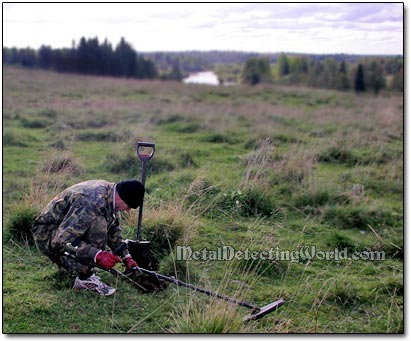Types of Metal Detecting Activities, page 10:
CACHE HUNTING TYPE II - Detecting Coin Hoards on Undisturbed Grounds
General Info, Tips and Types of Metal Detectors Required
This type of cache hunting is about searching for coin hoards and caches of other valuables at the formerly populated locations that have NEVER BEEN PLOWED or disturbed by other means.
Such areas may include village sites situated on hill sides, steep river banks and rough terrain. If the cache was buried at shallow depths, it can be easily discovered with even a cheap metal detector.
If the coin hoard was buried deep and at the site that was inhabited for a long time, this type of cache hunting is considered to be the most difficult task for the following reasons:
- 1) Having been undisturbed, a coin cache would have remained intact since it was buried, and sometimes its depth may exceed the detecting depth of a regular metal detector.
- 2) A thick layer of junk (iron nails of all sizes, fragments of tools, scrap metal, etc.) that has accumulated on top of the coin hoard over many years may mask the hoard completely.
- 3) Being undisturbed by plowing, each iron junk target has built up a strong Halo Effect which makes this target sound like a silver coin despite the Discrimination feature being employed; excessive digging is unavoidable.
- 4) Utilizing All Metal mode to achieve a better detecting depth would cause appearance of zillions of audio signals which would make a detectorist begin getting a "hearing fatigue" earlier during the hunt.
Searching for Coin Cache on Undisturbed Ground

You should begin searching such a hunt site with a conventional land metal detector first while using search coils of different sizes (see details on my "Search Coil Size Applications" page) and following a grid pattern of detecting. And if you still have not found a coin cache, you should search the site with a 2-Box or Deep Seeking (a better choice) metal detector. The Pulse Induction (PI) deep seeking units can be adjusted to ignore small targets and detect only large objects (metallic containers) or large clusters of coins situated at depths that are not detectable by regular metal detectors.
This type of cache hunting requires a lot of patience, time, and a good stamina for digging up numerous junk targets. In the process, you might spend only 10% of the total time for research, but 90% of time will be spent for metal detecting.
Type II of cache hunting may include searching the old-time wells and digging old dumps and privies since the types of metal detecting activities often overlap. However, searching the old wells is extremly dangerous and requires certain skills attained through substantial experience that is not easy to get. Even though the old wells may conceal lots of treasures, I would not advise you to attempt this type of treasure hunting unless you possess the "know-how" and are physically prepared to face serious challenges.